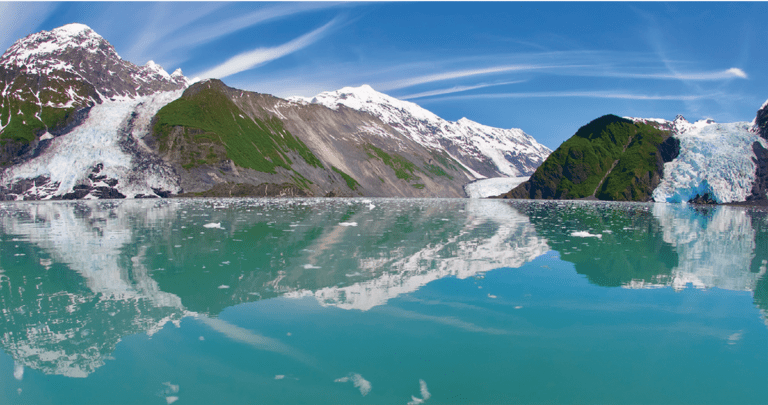Above: Barry Arm in Prince William Sound. The slope that could slide is pictured left of the Barry Glacier (middle glacier). Photo by William Rome
Public lands, the theme of this month’s issue, have many meanings. They are valued for recreation, heritage, tourism, preservation, and of course as longtime homelands for Alaska Native people. But they also hold scientific value, as shown by recent research of new landslide risks in Prince William Sound.
In 2020, scientists discovered a potentially large landslide that could trigger a tsunami in Barry Arm in western Prince William Sound. It followed retreat of the Barry Glacier, part of the Chugach National Forest. The glacier withdrew from beneath a massive wall of rubble that now hangs above the narrow ocean channel. If the “debuttressed” wall comes down, models show it could send up a tsunami of over 1,500 feet in the popular Harriman Fjord area. A six-foot wave could reach the busy community of Whittier, 30 miles away, in about 20 minutes.
Alaska has a history of landslide-generated tsunamis. During a 1958 earthquake, a slide in Lituya Bay 100 miles southeast of Yakutat created a wave of more than 1,700 feet. In 2015, a landslide in Taan Fjord, 100 miles northwest of Yakutat, triggered a wave of nearly 600 feet. The risk of tsunamigenic landslides may be increasing as glaciers retreat and alpine permafrost thaws due to human-caused climate change. It’s a concern near glaciers worldwide.
A multi-agency team led by USGS has installed seismic, weather, and other monitoring equipment on national forest lands near Barry Arm. Overflights and satellite data have also revealed other potentially dangerous landslides near shrinking glaciers in Prince William Sound, leading to plans for more instrumentation.
As their instruments go up, scientists work with Chugach National Forest managers to preserve the area’s wilderness and heritage so that the pursuit of science only minimally affects other values.
Find information on the Barry Arm landslide at the Alaska Department of Natural Resources website.


Comments are closed.